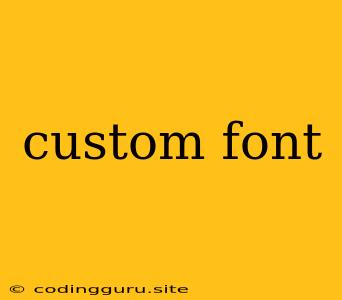Custom Fonts: Adding a Personal Touch to Your Designs
In the world of design, fonts are more than just letters; they are the building blocks of visual identity. They convey mood, personality, and even brand values. While there are countless pre-made fonts available, sometimes you need something unique, something that truly reflects your vision. This is where custom fonts come into play.
Why Use Custom Fonts?
- Unique Identity: Custom fonts make your designs stand out from the crowd. They provide a distinct and memorable visual signature that sets you apart.
- Brand Consistency: By using a custom font across all your marketing materials, you create a cohesive and recognizable brand identity.
- Enhanced Readability: A well-designed custom font can improve readability and make your text easier to digest.
- Emotional Connection: Custom fonts can evoke specific emotions and feelings, enhancing the impact of your message.
How to Create a Custom Font
Creating a custom font is a multifaceted process that requires specialized tools and knowledge. Here's a simplified overview:
- Concept and Design: Begin by defining the purpose and personality of your font. Consider the target audience, desired style, and overall message.
- Typography Software: Several software options are available for font creation, such as Adobe Illustrator, FontForge, and Glyphs.
- Character Design: Design each letter, number, and symbol, paying close attention to spacing, stroke thickness, and overall harmony.
- Kerning and Ligatures: Fine-tune the spacing between letters and create ligatures (joined characters) for a more polished and professional look.
- Font Family: Consider creating a font family that includes different weights (light, regular, bold) and styles (italic, bold italic) for versatility.
- Testing and Refinement: Test your font in various applications and make adjustments as needed to ensure optimal readability and aesthetic appeal.
- Exporting and Distribution: Once you are satisfied with the final product, export your font in various formats, such as .otf or .ttf, for distribution.
Tips for Using Custom Fonts Effectively
- Use Sparingly: Don't overuse custom fonts. Use them strategically to highlight key elements and create visual interest.
- Consider Accessibility: Ensure your custom font is readable for people with visual impairments.
- Test on Different Platforms: Ensure your font renders correctly across different devices, operating systems, and browsers.
- Obtain Legal Permissions: If you plan to use a custom font commercially, obtain the necessary licenses and permissions from the font designer.
Examples of Custom Fonts in Action
- Spotify's Logo Font: Spotify's iconic logo font, based on the typeface "Gotham", is a prime example of how a custom font can enhance brand recognition and create a unique visual identity.
- Netflix's Title Card Font: Netflix's custom title card font, "Netflix Sans," is a modern and bold font that perfectly reflects the streaming service's brand personality.
Where to Find Custom Fonts:
- Font Foundry Websites: Websites like MyFonts, FontSpring, and Creative Market offer a vast library of custom fonts for purchase.
- Free Font Websites: Several websites offer free, high-quality custom fonts. Google Fonts and Font Squirrel are popular choices.
- Font Design Communities: Connect with font designers and enthusiasts on platforms like Behance and Dribbble to discover and purchase custom fonts.
Conclusion
Custom fonts are a powerful tool for designers seeking to create unique and memorable visuals. They allow you to express your creativity, strengthen your brand identity, and elevate your designs to a new level. By understanding the process of creating and using custom fonts effectively, you can unlock a world of design possibilities and leave a lasting impact on your audience.
